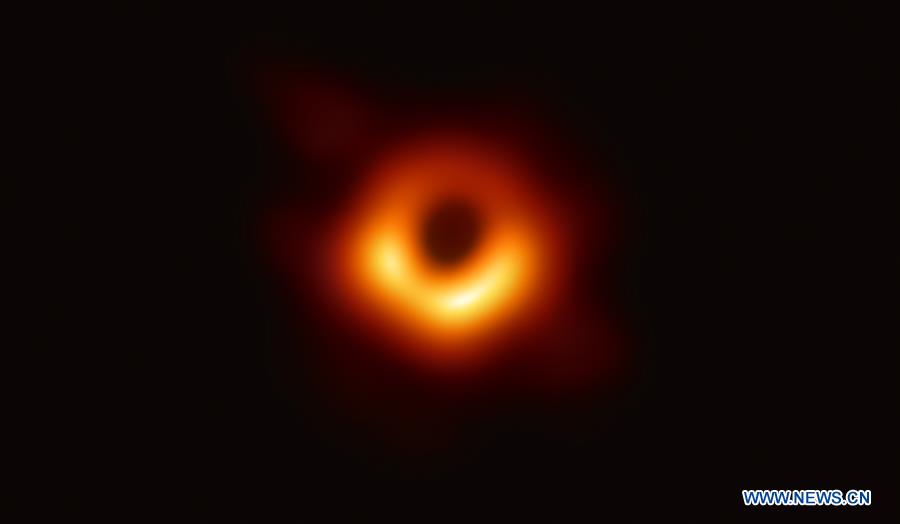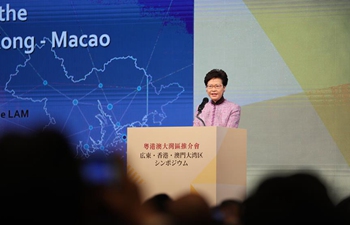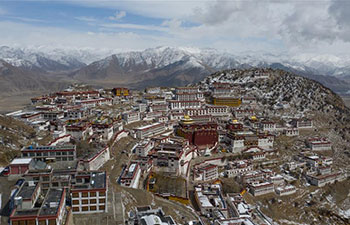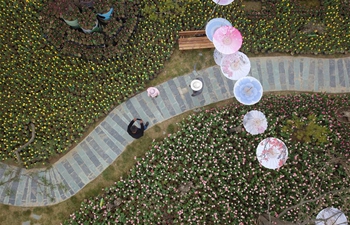
Photo provided by the Event Horizon Telescope (EHT) shows the first image of a black hole. (Xinhua/EHT)
WASHINGTON, April 10 (Xinhua) -- Astronomers said here Wednesday that they captured the first image of a black hole, unveiling the first direct visual evidence of an unseeable cosmic object and its shadow.
An Earth-sized virtual telescope called Event Horizon Telescope (EHT) linking eight ground-based radio telescopes around the globe "saw" the black hole at the center of massive galaxy M87, 55 million light-years from Earth with a mass 6.5 billion times that of the sun.
At a press conference, scientists revealed a donut-like structure with a dark central region and a bright ring, which is the black hole's shadow against a disc of glowing gas that falls onto the black hole.
It is a "surprising" finding, an "astonishment" and "wonder," giving "the strongest evidence that we have to date for the existence of black holes," Harvard astrophysicist Sheperd Doeleman, EHT's project director, described the image, whose release won immediate applause at the conference.
The landmark result offers scientists a new way to study the most extreme objects in the universe predicted by Albert Einstein's general relativity theory.
EINSTEIN IS RIGHT
Black holes are extremely compressed cosmic objects predicted by Einstein's theory of general relativity. It has a gravitational pull that is so intense that nothing, not even light, can escape it once inside a certain region called the event horizon.
Jason Dexter, EHT team member and an astrophysicist with Max Planck Institute for Extraterrestrial Physics, told Xinhua that the size and shape of the shadow are "a prediction of general relativity and detecting it would be the best evidence for the existence of a black hole in the universe."
Doeleman likened the ring structure with light orbiting the black hole to satellites orbiting the Earth, except that the black hole's gravity is so strong that it can grab the light.
The spinning ring's bottom is brighter than its top because "that's where material is coming towards us," moving close to the speed of light, Doeleman explained the image in an exclusive interview with Xinhua.
"All the light is being lensed around this photon orbit, much of it coming from behind the black hole," said Doeleman. The dark region is "where light is captured by the black hole," which was "predicted by Einstein."
"If immersed in a bright region, like a disc of glowing gas, we expect a black hole to create a dark region similar to a shadow," said chair of the EHT Science Council Heino Falcke with Radboud University.
"This shadow, caused by the gravitational bending and capture of light by the event horizon allowed us to measure the enormous mass of M87's black hole," said Falcke.
"Many of the features of the observed image match our theoretical understanding surprisingly well," said Paul T.P. Ho, EHT board member and director of the East Asian Observatory.
"The determination of the black hole mass agrees beautifully with earlier measurements inferred from the velocities of stars," Ma Chung-Pei, a professor of physics and astronomy at University of California, Berkeley, told Xinhua.
"Obtaining the same mass from two independent methods boost the confidence that we the black hole hunters are indeed on the right track," said Ma.
But "seeing is believing and an image is worth a thousand words," Avi Loeb, a Harvard theoretical physicist told Xinhua.
"A direct observation of black hole will be tremendous for our understanding of the spacetime that we are in," Yau Shing-Tung, mathematician and a senior faculty member of Harvard's Black Hole Initiative, told Xinhua.
HERCULEAN MISSION WITH LUCK
Creating the virtual telescope EHT was a formidable challenge which required upgrading and connecting a worldwide network of radio telescopes deployed at a variety of challenging high-altitude sites, including volcanoes in Hawaii and Mexico, mountains in Arizona and the Spanish Sierra Nevada, the Chilean Atacama Desert, and Antarctica.
France Cordova, director of the U.S. National Science Foundation, described the mission as "a herculean task" that will imprint on people's memory at the press conference.
Black holes are so far away from us, and the biggest of them like M87 is "about the size of an orange on the Moon," Harvard astrophysical professor Andrew Strominger told Xinhua. "It was only through the ingenious efforts of the event horizon telescope collaboration that we were able to obtain."
The EHT observations use a technique called very-long-baseline interferometry (VLBI) that can synchronise telescope facilities around the world and exploit the rotation of our planet to form one huge, Earth-size telescope, enough to read a newspaper in New York from a sidewalk cafe in Paris.
Then, during two years afterwards, the researchers used a supercomputer called correlator and refined algorithms to merge the light, said Dan Marrone, EHT co-investigator and an associate professor of Astronomy at the University of Arizona.
Despite the sharpened tool and hard work, Doeleman still called the image-taking kind of a "coincidence."
The radio waves go through the hot gas, traveled 60,000 years through M87 and another 55 million years through intergalactic space into the Milky Way, and then they come to the Earth with obstructive water vapor in its atmosphere, explained Doeleman.
"Nature was very kind to us," he said.
CHINA CONTRIBUTION
A team of more than 200 scientists including Chinese astronomers worked to capture and develop the image, according to EHT.
Marrone told Xinhua after the press conference that China made direct contribution to the observations and data analysis as well, which are important work.
Doeleman recalled how he worked with Chinese researchers to build data-analyzing algorithms, to de-blur the image and to contribute to the VLBI technique.
China is also helping greatly with the East Asian Observatory to run the James Clerk Maxwell telescope in Hawaii, making "very, very important" contribution, according to him.
Sera Markoff, a member of EHT Science Council and a professor at the University of Amsterdam, told Xinhua that she expected to have a Chinese telescope included into the EHT network, since "China is investing an enormous amount of money into new telescope facilities."
Doeleman revealed that EHT may include a space telescope into its network and China's a potential partner, and "we've already been talking a little bit with China" about "taking antennas into space."
"Breakthroughs in technology and the completion of new radio telescopes over the past decade enabled our team to assemble this new instrument, designed to see the unseeable," said Doeleman.













